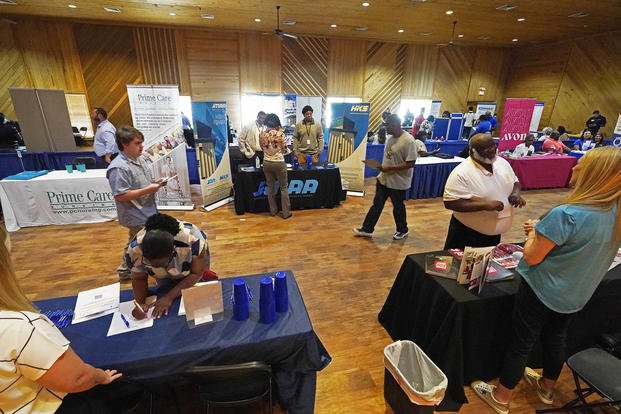WASHINGTON -- The latest U.S. job market report offered some relief to the market jitters over a stalling economic growth, but new-job creation pace and persistently high long-term unemployment problem showed that the labor market and economy are still sputtering.
The U.S. unemployment rate edged down to 9.1% in July 2011 from 9.2% in June, after ticking up for three consecutive months through June, the Labor Department reported on Friday.
The nonfarm sector added 117,000 new jobs across the country last month, far short of the 200,000 monthly level that economists believe robust enough to slash the unemployment rate over the long run. Still, it offered some hope to investors after a plunge of the Wall Street on Thursday.
House Majority Leader Eric Cantor (R-Va.) on Friday said that the unemployment remained horribly high, and the government should endeavor to make it easy for businesses to expand and hire.
The decline in the unemployment rate was entirely due to a drop in labor-force participation rate, not an increase in the share of workers with jobs, said Heidi Shierholz, an economist with the Washington-based Economic Policy Institute.
The total number of unemployed Americans stood at 13.9 million, still almost double the level before the recession. In July, the number of long-term unemployed who have been jobless for at least 27 weeks stood at 6.2 million, accounting for 44.4% of the total unemployed, not far off a record high of 45.6% in May 2010, evidence of a still bleak job market.
"While the better-than-expected report is welcome news, the unemployment rate remains unacceptably high, and faster growth is needed to replace the jobs lost in the downturn," Austan Goolsbee, chairman of the Council of Economic Advisers, said Friday on the White House blog.
Bipartisan action is needed to help the private sector and the economy grow, including measures to extend both the payroll tax cut and unemployment insurance, as well as passing the pending free-trade agreements, the patent reform bill and an infrastructure bill to create badly needed jobs, urged Goolsbee, President Barack Obama's top economic adviser.
With the U.S. economic growth staying in low gear in the first half of this year, the economy did not produce enough jobs to dent the large inventory of unemployed workers.
Although the department upwardly revised the newly added jobs in May and June, there are merely 72,000 jobs added per month on average from May to July.
Businesses added 154,000 jobs across different sectors in July, but governments cut 37,000 jobs last month because of spending cuts.
Employment in state governments shed 23,000, almost entirely due to a partial shutdown of the Minnesota state government. Local governments slashed 16,000 jobs, and the federal government added 2,000 jobs.
State and local governments have shed over half a million jobs since August 2008, said Shierholz.
Of the private-sector job gains last month, 112,000 were in private service-providing industries, and 42,000 were in goods-producing industries.
The manufacturing sector added 24,000 jobs in July and retail trade created 26,000, while health care employment grew by 31,000. The financial sector slashed 4,000 jobs, while construction employment increased 8,000 last month.
Obama said Friday that his "singular focus" now is to jump-start the nation's job creation and economic growth, as he has cranked up his reelection bid.
Obama urged the private sector to commit to hiring or training 100,000 unemployed veterans and their spouses by the end of 2013, and he proposed tax credits for those businesses supporting the government's job-creation initiative.
White House figures revealed that around 1 million U.S. veterans were unemployed as of June.
The U.S. labor market is now 11.1 million jobs below the level needed to restore the pre-recession unemployment rate of 5% in December 2007. To get back to the pre-recession unemployment rate by the middle of 2014, the nation needs to add roughly 400,000 jobs every month between now and then, Shierholz said.
Want to Know More About the Military?
Be sure to get the latest news about the U.S. military, as well as critical info about how to join and all the benefits of service. Subscribe to Military.com and receive customized updates delivered straight to your inbox.











